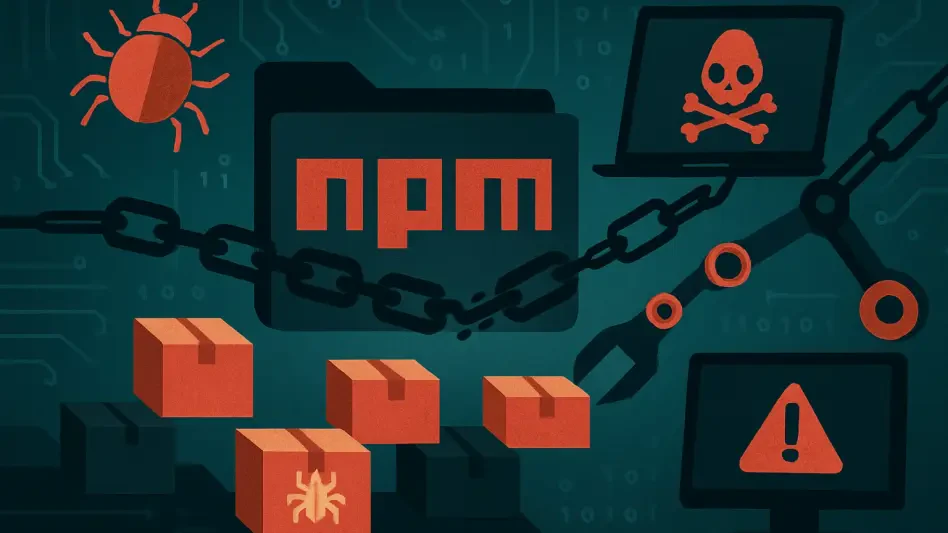Imagine a single breach in a widely trusted software registry cascading into a global crisis within mere hours, affecting one in every ten cloud environments, and exposing the vulnerabilities of our interconnected digital world. This alarming scenario unfolded with a recent supply chain attack on npm, the world’s largest software registry, where malicious code infiltrated systems at an unprecedented speed. Reports indicate that within just two hours, 10% of cloud setups were compromised by crypto-stealing malware hidden in trojanized packages. This roundup dives into diverse perspectives from industry leaders and security vendors to unpack how this attack happened, why it spread so rapidly, and what steps can be taken to safeguard cloud systems from similar threats.
Exploring the npm Breach: How Did It Happen?
Social Engineering as the Gateway to Compromise
Security analysts have highlighted social engineering as the primary tactic used by threat actors to gain access to trusted npm accounts. By manipulating human trust, attackers successfully hijacked the account of a well-known developer, subsequently publishing malicious packages that carried crypto-stealing payloads. This method underscores a critical vulnerability in digital ecosystems where personal trust can be weaponized against even the most vigilant communities.
Insights from cloud security vendors emphasize the sophistication of these attacks, noting that the malware was designed to intercept cryptocurrency transactions by altering wallet APIs. This allowed attackers to redirect funds to their own accounts seamlessly. The consensus among experts is that such tactics exploit not just technical gaps but also the inherent reliance on familiar names within the developer sphere.
A recurring concern among industry observers is the difficulty in detecting these breaches early. Many argue that current security protocols for account management on platforms like npm may need a comprehensive overhaul to prevent unauthorized access through deceptive means. This viewpoint drives home the need for stronger authentication measures and user education on phishing risks.
Rapid Spread Across Cloud Systems
The speed at which the malicious code propagated has left many in the tech community stunned. Within a two-hour window, compromised packages were integrated into frontend builds and web assets, affecting a staggering portion of cloud environments. Security firms have pointed out that automated build processes and cached assets played a significant role in this rapid distribution, amplifying the attack’s reach.
Differing opinions emerge on the root causes of this swift infiltration. Some experts focus on the inherent risks of dependency on vast ecosystems like npm, where a single corrupted package can ripple through countless systems. Others highlight that the lack of immediate validation checks in many build pipelines allows malicious code to slip through unnoticed until significant damage is done.
There is also shared alarm over the real-world impact, with data showing malicious bundles present in numerous cloud setups even after quick removal of the affected packages. This situation has sparked debates on whether current incident response times, though rapid, are sufficient to curb widespread exposure in highly interconnected environments.
Scope of the Threat: Beyond a Single Incident
Multiple Accounts Under Siege
Research from various security entities reveals that the campaign extended beyond a single developer account, targeting additional npm profiles such as one associated with “duckdb.” Malicious packages under this campaign were identified and removed swiftly, often receiving minimal downloads, which suggests attackers might be testing varied approaches to refine their strategies.
Analysts differ on the implications of these low download counts. Some believe quick mitigation indicates improving responsiveness within the npm community, potentially deterring large-scale damage. However, others caution that such incidents could be precursors to more insidious attacks, possibly involving backdoors that remain undetected in the sprawling registry.
A broader concern is the pattern of targeting multiple accounts, which points to a coordinated effort to exploit systemic weaknesses. Industry voices stress that assuming safety after rapid package removal might be premature, urging continuous monitoring and reassessment of trust mechanisms within open-source platforms to prevent future breaches.
Cloud Dependency as a Double-Edged Sword
Modern cloud architectures, heavily reliant on npm for rapid development, have been identified as a key factor in amplifying the impact of supply chain attacks. Experts note that the interconnected nature of cloud systems enables threats to scale quickly, turning a localized breach into a widespread issue almost instantly.
Comparisons with past npm incidents reveal a troubling trend of increasing sophistication in attack methods. Security researchers warn that as cloud adoption continues to grow, the potential for similar exploits will only intensify. Some advocate for a fundamental shift in how dependencies are managed, suggesting stricter vetting processes to reduce inherent risks.
Speculation on future vulnerabilities also varies, with certain analysts questioning whether current security practices can keep pace with evolving threats. A common thread among opinions is the urgent need for proactive measures, including real-time threat detection and enhanced collaboration across the tech ecosystem to address these challenges comprehensively.
Safeguarding the Future: Collective Strategies for Defense
Actionable Tips from Security Leaders
Drawing from a range of recommendations, several actionable steps emerge for protecting cloud environments. Security vendors suggest blocklisting known malicious packages and rebuilding systems from clean caches to eliminate any lingering compromised dependencies. This approach aims to reset affected systems to a secure baseline.
Further advice includes invalidating affected content delivery network assets to prevent cached malicious files from persisting. Adding client-side integrity checks is also widely recommended as a temporary safeguard for user interfaces, alongside disabling sensitive modules like tipping or donation features during active threats.
Daily updates to blocklists and anomaly scans are advocated as essential practices for ongoing protection. These measures, combined with telemetry reviews during specific threat windows, are seen as critical by many in the field to identify and mitigate risks promptly, ensuring that developer and security teams remain agile in their response.
Systemic Changes for Long-Term Security
Beyond immediate fixes, there is a strong push for systemic improvements in software supply chain security. Industry perspectives converge on the need for enhanced account protection protocols on platforms like npm, with suggestions ranging from multi-factor authentication to more robust user verification processes.
Another focal point is fostering community-driven vigilance, where developers and organizations share threat intelligence in real-time. Some experts propose integrating automated dependency scanning tools into development workflows to catch vulnerabilities before they are exploited, reducing the window of opportunity for attackers.
A final area of agreement is the importance of education and training to combat social engineering tactics. Many believe that equipping users with the knowledge to recognize and resist manipulation attempts could serve as a first line of defense, complementing technical solutions in building a more resilient ecosystem.
Reflecting on the npm Attack: Steps Taken and Paths Ahead
Looking back, the npm supply chain attack served as a stark reminder of the vulnerabilities embedded in interconnected cloud systems, with insights from various industry players painting a picture of both urgency and opportunity. The rapid spread of malicious code to 10% of cloud environments within hours underscored the fragility of current dependency models, while the identification of multiple compromised accounts highlighted a persistent and evolving threat landscape. Moving forward, organizations were encouraged to adopt a multi-layered defense strategy, incorporating blocklisting, clean rebuilds, and continuous monitoring as foundational steps. Additionally, exploring collaborative platforms for sharing threat intelligence emerged as a vital consideration to strengthen community resilience. As the tech world navigated these challenges, the emphasis shifted toward building robust frameworks that could anticipate and neutralize risks before they escalated into widespread crises.








